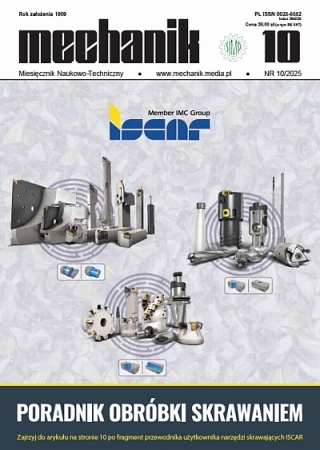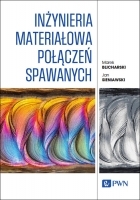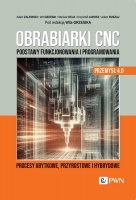Modeling the effect of resistivity of the heating element on temperature distribution in the Bridgman-type toroidal anvils
Modelowanie wpływu rezystywności elementu grzejnego na rozkład temperatury w toroidalnym kowadle Bridgmana
Mechanik nr 02/2015 - Artykuły z Międzynarodowej Konferencji Innovative Manufacturing Technology IMT 2014 zamieszczone na płycie CD
ABSTRACT: The simulation was aimed to determine the effect of resistivity, one of the parts of the heating element on the temperature distribution in the sample during the sintering process in the Bridgman-type toroidal apparatus.
Calculations were performed using finite element method (FEM). Geometric model which mapped graphite heating element, the sintered material and mineral-polymer gaskets, which fulfill the role of a pressure medium, as well as electrical and thermal insulator was used. Heating in the model is realized by the flow of electric current which changes as a function of time, corresponding to the actual values occurred during the sintering process. Model was calibrated on the basis of the measurement results, in which the registered temperature changes caused by changes in the electric power in time. The calibrated model showed a good agreement with experimental data.
Then, a series of analyzes were performed in which the resistivity of one of the parts of the graphite heating element was progressively increased. Comparison of obtained temperature distribution results indicate, that the use a material of higher resistivity, leads to a reduction of the power required to obtain the expected temperature. However, it can negatively influence on temperature distribution in the sample during the sintering process.
KEYWORDS: Bridgman anvil, toroidal anvil, heating element resistivity, graphite heating element, HPHT sitering, temperature distribution.
STRESZCZENIE: Przeprowadzona symulacja miała na celu określenie wpływu rezystywności jednej z części składowych elementu grzejnego na rozkład temperatury w próbce w trakcie procesu spiekania w toroidalnym kowadle Bridgmana. Obliczenia wykonano metodą elementów skończonych (MES) i wykorzystano w nich model geometryczny, odwzorowujący grafitowy element grzejny, w którym umieszczony był spiekany materiał, oraz otaczające go kształtki mineralno–polimerowe, pełniące równocześnie rolę medium przenoszącego ciśnienie i izolatora elektrycznego i cieplnego. Nagrzewanie w modelu było wywołane przepływem prądu elektrycznego, którego moc odpowiadała rzeczywistym wartościom stosowanym podczas procesów spiekania z wykorzystaniem urządzenia wysokociśnieniowo-wysokotemperaturowego - HPHT (High Pressure High Temperature). Kalibrację modelu, wykonano w oparciu o wyniki pomiaru, w którym rejestrowane były zmiany temperatury wywołane zmianami mocy prądu w czasie. Skalibrowany model, wykazywał dobrą zgodność z danymi doświadczalnymi. Wykonano szereg analiz, w których rezystywność jednego z elementów składowych grafitowego elementu grzejnego była stopniowo zwiększana. Porównanie uzyskanych wyników rozkładu temperatury wskazuje, że zastosowanie materiału o wyższej rezystywności prowadzi do obniżenia mocy potrzebnej do uzyskania żądanej temperatury, jednak może niekorzystnie wpływać na jej rozkład w próbce podczas procesu spiekania.
SŁOWA KLUCZOWE: kowadło Bridgmana, kowadło toroidalne, rezystywność elementu grzejnego, grafitowy element grzejny, spiekanie HPHT, rozkład temperatury.
BIBLIOGRAFIA / BIBLIOGRAPHY:
- EREMETS M.I. High Pressure Experimental Methods. Oxford University Press; 1996.
- SUNG C-M. A century of progress in the development of very high pressure apparatus for scientific research and diamond synthesis. High Temp Press 1997,29,253–93. doi:10.1068/htrt111.
- KING J.H. Choice of materials for use in compressible-gasket high-pressure apparatus. J Sci Instrum 1965,42,374–80.
- PRIKHNA T.A. High-pressure apparatuses in production of synthetic diamonds (Review). J Superhard Mater 2008,30,1–15. doi:10.3103/S1063457608010012.
- KLIMCZYK P. Silicon Carbide - Materials, Processing and Applications in Electronic Devices. In: Mukherjee M, editor. cdn.intechweb.org, InTech; 2011, 309–34. doi:10.5772/852.
- DUTKIEWICZ J., MAZIARZ W., JAWORSKA L., ZAPALA K. Ultra High Pressure Consolidation of Ball Milled Nanocrystalline TiTaNb Alloys. Mater Trans 2007,48,909–14. doi:10.2320/matertrans.48.909.
- FUKUNAGA O., YAMAOKA S., AKAISHI M., KANDA H., OSAWA T., SHIMOMURA O., et al. Large-Volume Flat Belt Apparatus. In: Manghnani MH, Syono Y, editors. High-Pressure Res. Miner. Phys. A Vol. Honor Syun-iti Akimoto, vol. 39, Washington, D. C.: American Geophysical Union; 1987, 17–28. doi:10.1029/GM039.
- DEBORD R., LEGUILLON D., SYFOSSE G., FISCHER M. A finite element study of a high-pressure/high-temperature cell for simultaneous X-ray and ultrasonic measurement. High Press Res 2003,23,451–63. doi:10.1080/08957950310001609421.
- FANG L., HE D., CHEN C., DING L., LUO X., Effect of precompression on pressure-transmitting efficiency of pyrophyllite gaskets. High Press Res 2007,27,367–374. doi:10.1080/08957950701553796.
- KONDRAT’YEV A.I., VOHRA Y.K. Finite-element modeling of stresses and strains in a diamond anvil cell device: case of a diamond-coated rhenium gasket. High Press Res 2007,27,321–331. doi:10.1080/08957950701557573.
- FIGUEIREDO R.B., PEREIRA P.H.R., AGUILAR M.T.P, CETLIN P.R., LANGDON T.G. Using finite element modeling to examine the temperature distribution in quasi-constrained high-pressure torsion. Acta Mater 2012,60:3190–3198. doi:10.1016/j.actamat.2012.02.027.
- PIERSON H.O. Handbook of Carbon, Graphite, Diamonds and Fullerenes. Oxford: Elsevier; 1993. doi:http://dx.doi.org/10.1016/B978-0-8155-1339-1.50001-3.
- PIERSON H.O. Handbook of refractory carbides and nitrides. Westwood, NJ: William Andrew Publishing; 1996.
- Fatigue Data at zero mean stress comes from 1998 ASME BPV Code, Section 8, Div 2, Table 5-110.1






















